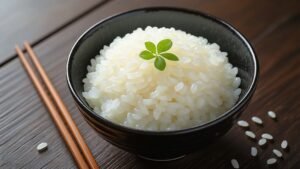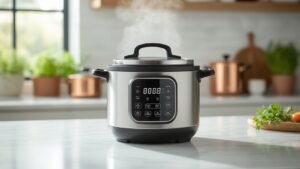Rice cooker delay timers have become my trusted kitchen companions over the years, and for good reason. These practical gadgets take the guesswork out of perfectly timed rice, whether you’re planning dinner hours ahead or wanting breakfast rice ready at dawn. As someone who’s cooked countless pots of rice, I’ve found these timers invaluable for both busy weeknights and lazy weekends.
They’ve saved me from hovering over the stove and freed up precious time for other tasks. Let me walk you through the five clever ways these timers work – they’re simpler than you might think, and once you start using them, you’ll wonder how you managed without.
Table of Contents
ToggleBasic Timer Functions and Programming Settings
Let’s look at the basic timer functions that make rice cookers so convenient to use. First of all, I love how these timers give you total control over when your rice starts cooking.
With delayed start programming, you can set your rice to begin cooking hours before you need it – perfect for busy days when you’re running in and out.
I’ve also found that understanding timer maintenance schedules is imperative for keeping your cooker running smoothly. It’s easy to check and reset your timer settings each time you use it. I always make sure to verify the clock is accurate and the timer is responding correctly.
When you’re programming your delay timer, you’ll notice how intuitive the controls are – usually just a few buttons to set your desired start time. It’s that simple to have perfect rice ready exactly when you want it.
Digital Display and Control Panel Operations

While many rice cooker features can seem complex at first glance, I’ve found that the digital display and control panel are actually quite user-friendly. I love how you can easily see all your timer settings adjustments right on the bright LED screen, making it simple to take control of your cooking schedule.
The buttons are typically well-marked and responsive, letting you quickly set your desired cooking times and programs. I’ve discovered that cooking process optimization is a breeze with the intuitive interface – just press a few buttons to select your rice type and preferred finish time. The display will show you exactly when your rice will be ready, and you can make adjustments on the fly if your plans change. It’s like having a personal kitchen assistant!
Multi-Stage Cooking Time Management

Modern rice cookers excel at handling complex multi-stage cooking through their sophisticated timing systems. I’ll show you how to make the most of your rice cooker’s multi-stage timing features, so you can enjoy perfectly cooked meals that fit your schedule. With customized cook settings and delayed start options, you’re in complete control of when and how your food cooks.
Today’s rice cookers bring precision timing to multi-stage cooking, giving you complete control over every step of meal preparation.
Set different cooking durations for each stage of your recipe, like soaking, steaming, and warming.
Program your cooker to start at your preferred time, up to 24 hours in advance.
Adjust cooking times based on your rice type and desired texture.
Create personalized cooking sequences that automatically shift between stages.
These smart timing features give you the freedom to prepare meals your way, whether you’re cooking simple white rice or crafting complex mixed-grain dishes.
Safety Features and Timer Limitations
Smart timing features are wonderful, but they need proper safety measures to protect both you and your appliance. I’m always impressed by how today’s rice cookers come equipped with automatic shut off mechanisms that kick in if the cooking cycle runs too long. You’ll love how these clever devices use temperature regulation controls to prevent overheating and burning.
I’ve learned that most delay timers have a maximum setting of 12-24 hours for food safety reasons. This helps prevent bacterial growth in your rice. If you’re planning to delay-cook, I recommend using the timer within a shorter window – ideally no more than 8 hours. The cooker will maintain safe temperatures and shut off automatically if anything goes wrong, giving you peace of mind while you’re away.
Energy Efficiency and Delayed Start Benefits
Delayed start features on rice cookers can markedly reduce your household energy consumption during peak usage hours. I love how these smart timers let you take control of when your rice cooker operates, saving you money while making meal prep more convenient.
Schedule your rice cooking for off-peak hours when electricity rates are lower, typically late evening or early morning. Monitor your energy consumption patterns through delayed start scheduling to optimize savings. Reduce strain on the power grid by shifting cooking times away from peak demand periods. Save time and energy by having perfectly cooked rice ready exactly when you need it.
I’ve found that using these delay timers not only helps my budget but also gives me the freedom to plan meals around my schedule while being environmentally conscious.
Frequently Asked Questions
Can Rice Cookers With Delay Timers Be Used for Other Grains Besides Rice?
I love sharing that modern rice cookers offer delightful grain variety options! You can cook quinoa, barley, and oats – just make smart cooking time adjustments to guarantee perfect results every time.
What Happens if There’s a Power Outage During the Delayed Cooking Time?
I’ll tell you straight – if there’s a power outage, your rice cooker will reset. The length of power outage duration affects everything, so I always have a meal preparation contingency plan ready.
Will Extended Delay Times Affect the Quality of Special Rice Varieties?
I used to think delayed rice was carefree, but here’s reality: extended soaking affects texture changes in specialty grains and impacts nutrient retention. You’ll want shorter delays for your precious exotic varieties.
Can I Use the Delay Timer Function When Cooking With Broth Instead Water?
I wouldn’t risk using broth with a delay timer since soaking time duration affects liquid absorption rate. The broth could spoil at room temperature, so it’s safer using water instead.
Does Frequent Use of Delay Timer Features Reduce the Appliance’s Overall Lifespan?
I’ve found that using delay timers doesn’t affect lifespan when following proper food storage rules and ideal timer settings. Your rice cooker’s durability depends more on general maintenance and quality.






